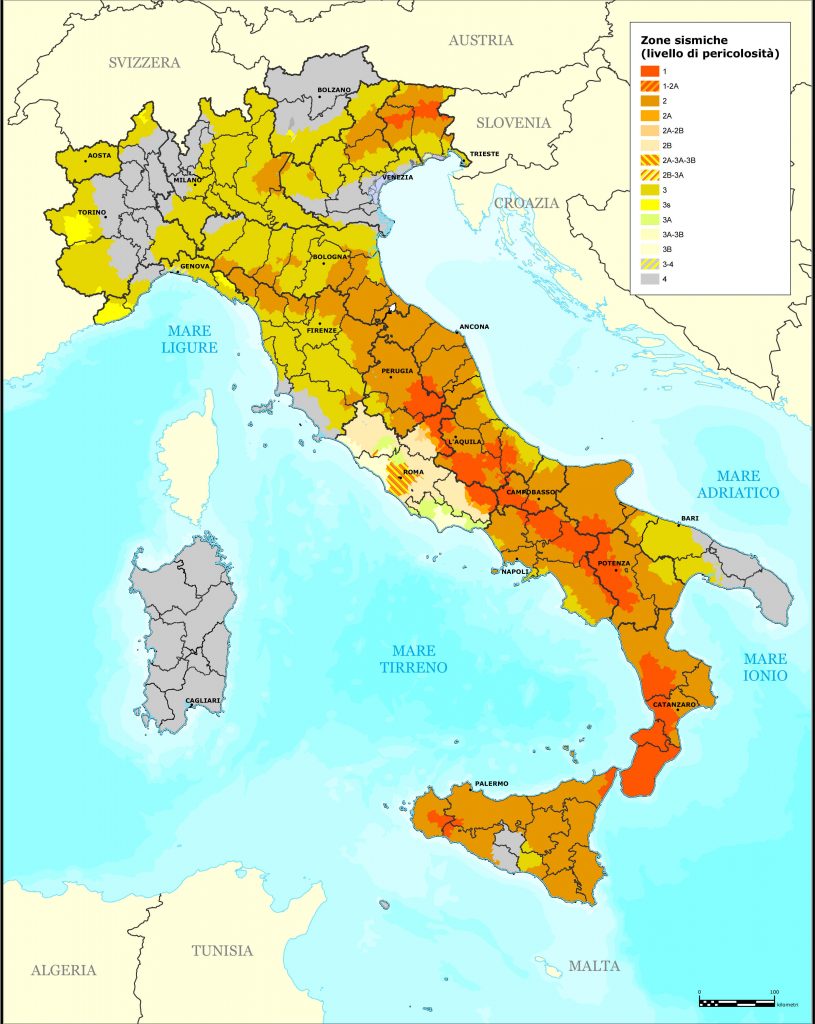
July 10, 2021
Italy’s seismic situation
Every eight years, on average, Italy experiences an earthquake whose consequences range from serious to catastrophic. Unfortunately, Italy has been rocked by numerous earthquakes in the past that have razed many cities to the ground, with huge loss of life. Italy has a high seismic hazard rating (based on seismic event frequency and strength), very high vulnerability (given the fragility of our residential, commercial and industrial building stock, and infrastructure) and extremely high exposure (given our population density and our unique historical, artistic and monumental heritage found nowhere else in the world)
Our country, therefore, is at high seismic risk, in terms of casualties, damage to buildings and the direct and indirect costs expected following an earthquake. Seismic risk, determined by the combination of the hazard rating, vulnerability and exposure, is the measure of the damage expected within a given window of time, based on the type of seismicity, strength of buildings and to what extent the natural environment has been transformed to meet human needs (nature, quality and quantity of exposed property).
In Italy, the loss of over 160,000 lives in little more than 100 years could be prevented with the necessary work, as it’s not the earthquakes that kill but the buildings. Having the appropriate work done is the smart choice and a far-sighted one.

As you can see from the tables below, seismic risk in Italy is anything but low. Unfortunately, our country is characterized by very frequent strong shocks that, every 6/8 years on average, cause serious devastation in terms of both human lives and structural and infrastructural damage. We have perhaps consistently underestimated the risk and the extent of said events, but we cannot turn a blind eye. In the last 30 years alone, there have been around 150,000 shocks. While the best known are those that have occurred since the beginning of the 20th century, Italy was affected by frequent strong earthquakes even before then.
Over 160,000 lives lost in little more than 100 years is certainly no small number, and while there’s no call for panic, we can’t keep addressing the issue once it’s too late. Prevention is the only tool we have to defend ourselves. A forward-thinking choice, an investment in our future, our families and our businesses. In the second millennium, out of 1,300 destructive earthquakes hitting the Mediterranean, those affecting Italy accounted for no less than 500, making our country the unfortunate record holder.
The most significant earthquakes from the 20th century to date:
| Date | Place | Magnitude | Fatalities |
| 03/01/1117 | Verona, Brescia, Bergamo, Milan | 6.49 | 30.000 |
| 04/02/1169 | Catania and Sicily | 6.60 | 20.000 |
| 25/01/1348 | Carinthia and Friuli | 6.66 | 10.000 |
| 05/12/1456 | Molise and Sannio | 6.96 | 30.000 |
| 27/03/1638 | Nicastro | 7.00 | Oltre 10.000 |
| 11/01/1693 | Val di Noto | 7.41 | 60.000 |
| 05/02/1783 | Reggio Calabria and Messina | 6.91 | 50.000 |
| 08/09/1905 | Lamezia terme | 7.00 | 557 |
| 23/10/1907 | Canolo | 5.90 | 167 |
| 28/12/1908 | Calabria and Sicily | 7.20 | 120.000 |
| 07/06/1910 | Irpinia | 5.90 | 50 |
| 08/05/1914 | Linera | 4.30 | 70 |
| 13/01/1915 | Avezzano | 7.00 | 33.000 |
| 24/11/1918 | Giarre | 4.30 | 100 |
| 29/06/1919 | Mugello | 6.20 | 100 |
| 07/09/1920 | Fivignano | 6.40 | 300 |
| 23/07/1930 | Irpinia | 6.70 | 1.404 |
| 18/10/1936 | Foothills of the Alps, Treviso district | 5.90 | 19 |
| 15/01/1968 | Belice , Sicily | 6.40 | 370 |
| 06/02/1971 | Tuscania | 4.50 | 31 |
| 06/05/1976 | Friuli | 6.40 | 989 |
| 23/11/1980 | Irpinia | 6.90 | 2.914 |
| 26/09/1997 | Assisi | 6.10 | 11 |
| 31/10/2002 | San Giuliano di Puglia | 5.80 | 30 |
| 06/04/2009 | L’Aquila | 6.30 | 308 |
| 20 e 29/05/2012 | Emilia Romagna | 6.10 / 5.80 | 27 |
| 24/08/2016 e 26 e 30/10/2016 | Central Italy | 6.00 / 5.90 / 6.50 | 299 |






